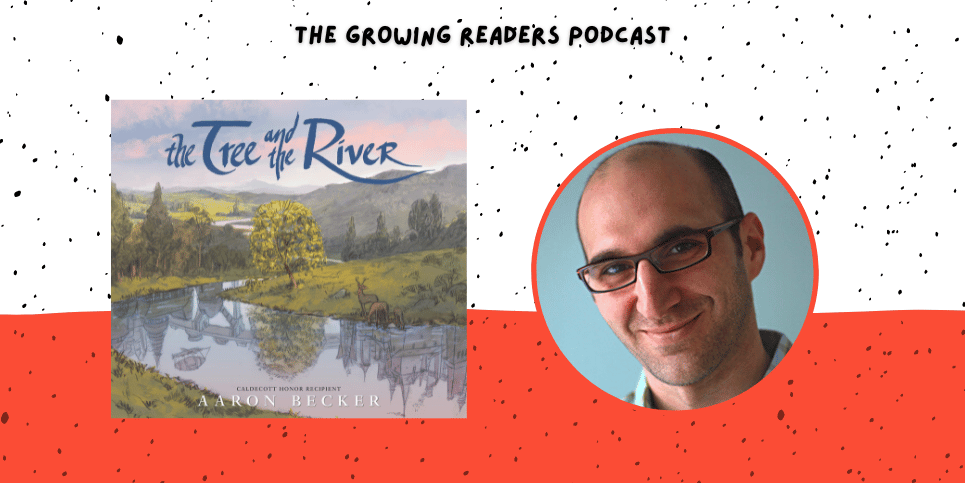A podcast interview with Aaron Becker
The Children’s Book Review
In this episode, we have the master of wordless picture books, Caldecott Honor–winning Aaron Becker. He talks about his new book, The Tree and the River.
This wordless stunner manages to cover the gloomy topics of societal and environmental upheaval and the impact that we can have on the natural world while leaving readers with hope and, hopefully, some ambition to do better.
Listen to the Interview
The Growing Readers Podcast is available on all major platforms. Subscribe Now.
Aaron Becker is the best-selling author of the award-winning Journey trilogy, along with several other books for children young and old. His love of travel led him to the city of Granada, Spain, where a rich history of layered civilizations inspired him to write The Tree and the River. To prepare for the story’s illustrations, he first constructed a scale model of the book’s rolling landscape, which he then slowly transformed with clay and wood over many months. When he’s not home with his wife and two daughters, Aaron Becker can be found creating something new in his studio in western Massachusetts.
Read the Interview
Aaron Becker: Hi, Aaron. Welcome to The Growing Readers Podcast. I am so thrilled to have you on the show today.
Aaron Becker: Thanks for having me. It’s a pleasure to be here.
Bianca Schulze: Well, since it is your first time on the show, I have a question that I like to ask all children’s book creators, and that is just in an overall sense, what drives you and guides you in creating books for children?
Aaron Becker: Oh, wow, that’s a great question. I wonder what kind of answers you get. Probably all over the map. I think, for me, it’s like a curiosity around my own interests. And I often do not start out projects thinking about what kind of book I want to make for a child. I’m more thinking, like, what’s interesting to me right now and what do I want to explore, what ideas or what’s important? And that’s sort of my reference point. And often editors or crit people in my crit groups or whatever will ask, well, what age did you imagine this story being for? I don’t know. I guess a 48-year-old? Yeah, I would say that’s sort of where I start from.
Bianca Schulze: So, what do you think it is that helps you to stay true to your vision versus creating for a specific age group or a marketplace?
Aaron Becker: Oh, wow. That’s a great question. I mean, part of that is just the dumb luck of having my debut book being successful, which gave me the opportunity and privilege to chase whatever ideas came to me versus feeling like, how am I going to sell this to someone and how are they going to pick it up? So, I think that’s just, like, one of those things that I feel really fortunate about. I don’t think that’s the norm.
I often think, I mean, before I did kids’ books, I worked in commercial illustration, and I was constantly having to kind of consider who my audience was or what the art director wanted or guess what they were looking for. And man, is it such a dream to be able to finish a book and start a new one where I’m like, okay, well, where am I at now? And what is the story that I feel like I need to get out of inside me?
Bianca Schulze: On that note, let’s dig into The Tree and the River. What was your original vision, or I guess, excuse the pun, your seed of inspiration for this story?
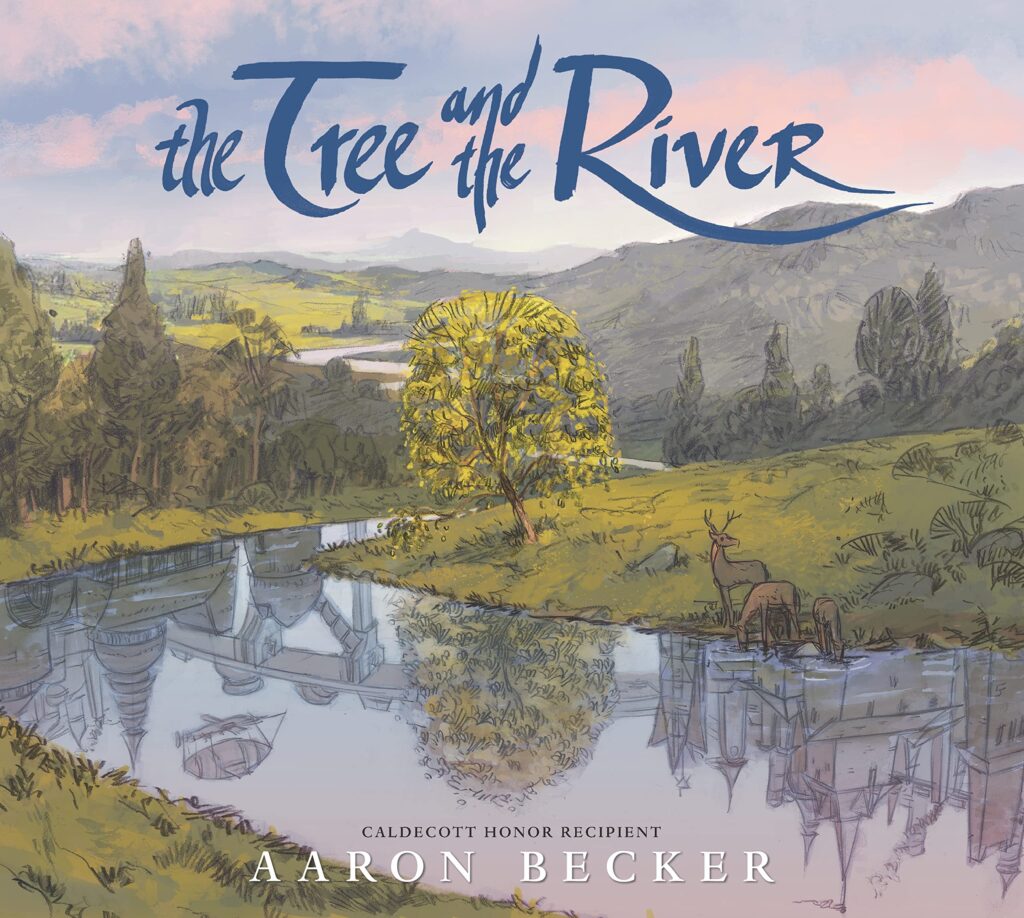
Aaron Becker: Yeah, I don’t know if you know the book A Stone for Sascha, which is another wordless book that I did. It’s about a girl who loses her dog and grieves through sort of this; well, the book explores history and the way we’re all sort of connected through time, and that the way through as time progresses in the universe. It’s sort of like at this point that everyone goes through, and maybe that helps in grief, understanding that it’s something others have dealt with. And that whole idea came about from this trip that my family and I took, where we lived in Spain for a year with our, at that time, five-year-old daughter—four-year-old daughter.
We lived in this city called Granada, which is, like, built upon Roman ruins and then Catholic castles and cathedrals. It’s got all these layers of time and history built into it. And that experience of seeing actual buildings that were built on foundations of other entire cultures really hit me deeply. So, A Stone for Sascha kind of came out of that awareness of time and experience of time, and I think I just wasn’t done with it. And I wanted to do something maybe even more specific to that idea of what I experienced in Granada.
And so, The Tree and the River, which follows human history through, like, 500 years from the perspective of a tree and a river, does just that. It kind of speaks to these ideas that are kind of hard to explain with words, but somehow, somehow, the wordless format really does the trick.
Bianca Schulze: As it is a wordless picture book, will you talk us through finding specific storylines and details from spread to spread and building to building? It’d just be great for any listener that hasn’t had the opportunity to have a sneak peek yet just to sort of hear you talk through it and how to find this specific thread of storyline.
Aaron Becker: Sure. I mean, a lot of it is up to the reader to look through the details and find things that interest them. I was very careful from spread to spread to make things followable. Every single building. There’s not a single building in these cities that you see in these—if you haven’t seen the book, it’s basically like a very highly detailed bird’s eye view of a city. And so, at times, when it gets to be a giant city, there’s hundreds of buildings, and every single one was there for a purpose if you can believe it.
And so, the very first building that you see being started is the most obvious. It’s like you just see it as a timber frame construction where a family has a little outpost in this kind of forested area by a river and a tree. They’re cutting down trees for their lumber, and they’re starting to build this house, this farmhouse, and by the next page, the house has been finished. But there’s also another family that’s moved across the river, across the way, and a couple of other buildings. And so, this initial building actually lasts for a while.
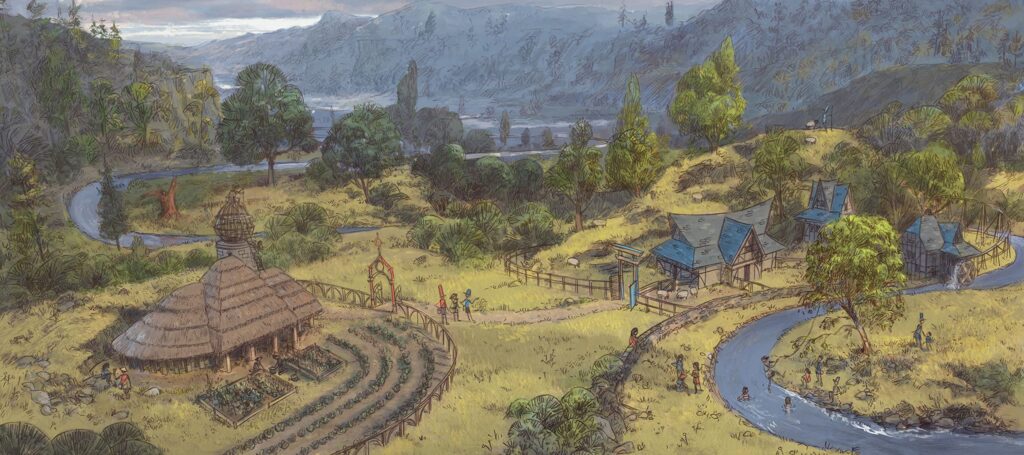
Let’s see—the third spread. It’s still there, but now it’s just one of many buildings inside of a walled city, and then the walled city expands, and the river is moved by the people. But still, that initial building is there. This might be over the course of 40, 50, or 60 years. And so, the building is getting older. The roofing has to be replaced. Some of the walls are redone, just like it is. And then suddenly, between the fourth and fifth spread, there’s been a conflict between these two developing cultures, and the building is gone. It’s just totally evaporated. So, there’s another building in the story where it starts out as part of the farm. It’s on the river, it has a water wheel, and it becomes, at some point, a cafe, maybe.
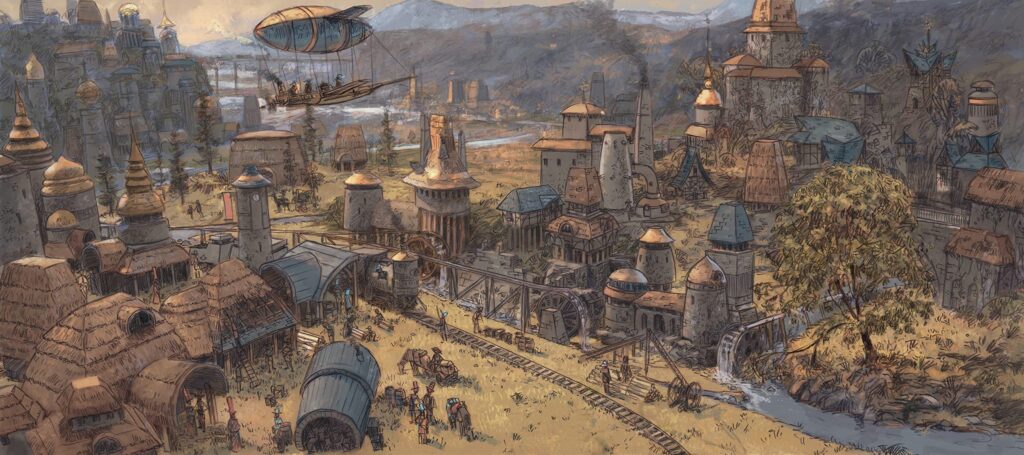
And then by the time we’re in the future city, it’s a disco, like, a glowing entry of a disco. So those were all things that I just thought about how would this building evolve over time, and what would people use it for?
Bianca Schulze: What do you think will be the most surprising thing that readers will notice?
Aaron Becker: Oh, I can’t give it away. I’ll just say there is something on the very first spread of the book when it looks like a kind of undiscovered country, a place where no one has ever been before. There’s a clue. Like, often, the distance may be hidden behind the jacket flap that might give you a sense that maybe this is not the history of our own civilization but one that might come after ours.
Bianca Schulze: This book is really an exploration of civilization, and sometimes I feel a bit conflicted in the children’s book world in the sense that when you’re writing or creating a book and, in this sense, it’s wordless, but it’s often said not to be preachy and not to have obvious messages. But it’s hard to avoid at the end of a picture book that there isn’t some kind of intention behind the storyline.
And so, I’m wondering, in terms of you creating this story, did you have an underlying message that you were hoping would come across, or obviously, we want the reader to take away whatever is meaningful to them, and they will. And that is the beauty of a wordless picture book. But for you, the creator, is there an underlying theme, like a very specific one, that you were intending to explore?
Aaron Becker: Wow. I have to say that I don’t have one, and I don’t know if that’s like—I don’t think that’s a flaw in this case. I think it can be. You have to kind of know what it is that you want to say. But I’ll be honest, in some ways, this is like a climate change angst book for me. And how do you write a climate change angst book for an audience of children or even adults and leave with any sort of I knew I needed to leave some sense of hope at the end, or at least of rebirth, which seemed really important.
But I also felt like I think the openness of the theme and the openness of whatever message one might get out of the ending of the story is sort of part and parcel with how I feel personally. Kind of going back to your first question of, like, where do my ideas? What am I going for when I make something? And it’s like, sort of wrestling with something, with the books that I make, like, what sort of idea. And I knew I wanted to show the rise and fall of a civilization. And I have mixed feelings about that. In some ways, I think our civilization does need to change in some major way for us to get through the next century of human existence on this planet.
And so, I kind of feel like things maybe things do need to be torn down or changed in some way that might be terrible and bring a lot of suffering in it or to people and our civilizations. But at the same time, if you look long enough through human history and if you look deeply enough and you become less centered on your own experience of what you think civilization means, that’s already happened to many, many peoples throughout history.
And I think that’s what I was going for—is, let’s think about that. And, of course, it’s a complicated idea, and it’s not necessarily full of joy, and it’s not uplifting, but it’s also true, and it’s happened, and it is happening, and let’s think about it. Let’s be there for a little while in an approachable way.
Bianca Schulze: Yeah. And I think the key word that you said that I have taken away from reading The Tree and the River is the word hope. And I do feel as though it’s so important to explore these sorts of gloomy topics of, I guess, the negatives in society and what’s happening with our environment. It can be a scary topic, but I think the beauty of your book being wordless is that the reader can come to it and apply their own thinking to it, and then ultimately, you provide a nugget of hope at the end.
And I think that’s what will leave everybody feeling inspired to make the change that feels meaningful to them. So, I think for me the keyword that you said that touched me as a reader of your book is the word hope.
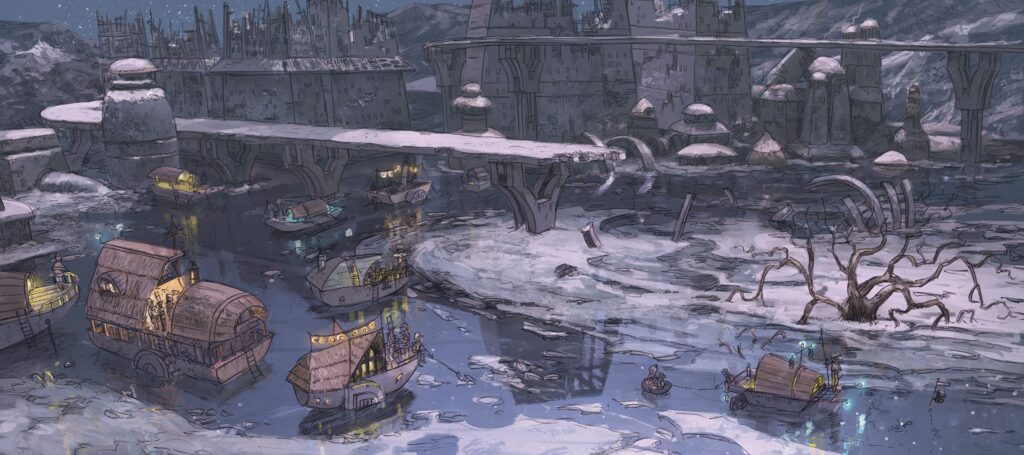
Aaron Becker: Yeah, I definitely think that is the message. By the end, I would just say, I think in answering your question, I was thinking, like, it wasn’t necessarily what I knew was going to happen. It wasn’t my intention. I didn’t set out to make a story about hope. I set out to make a story about something that was bothering me and confusing me, and I wanted to explore it.
And then I felt like, in the end, it needed that. It really needed that. I mean, in some ways, it’s a joyful book because it shows the way that all the little, teeny people you see in this book, they’re alive, and they’re doing stuff, and they’re makers, and they’re explorers, and there’s children and families and adults doing the things that adults do. It’s all of it. And I guess I wanted to hold all of that. And I think for a child, they need to have some sense of hope.
I’ll also say the last image of the book, not to give it away, but it does show the way humans interact with nature in a hopeful way by sort of a child touching a tree. And when I was in college, I had this sculpture professor who had us draw a tree every day of the semester, like, in some new way, like, approach this tree and draw it in a journal. And we kept this tree journal the whole term. And as the term was ending, I had been drawing this tree that was outside of my window because I thought, like, well, I need something that’s relatively easy to get to and that I’m going to do as a practice that’s not going to walk halfway across campus to find a tree.
So, I’d been looking at this tree from the vantage point of a distance and from a window. And, like, the last day, I went up to the tree, and I put my hand on this tree that I’d been paying so much attention to for three or four months of drawing in detail. And it was a really powerful experience. And I have no doubt in my mind that that feeling of connection to nature was what inspired the ending of the story.
Bianca Schulze: Well, let’s talk more about the creation of your art. So, will you share what the process looks like and the mediums that you use?
Aaron Becker: Oh, wow. Well, this one was totally strange for me because I normally work in watercolor and pen and ink, and I knew that the drawings in this were going to be so complicated and that following buildings to buildings, like from spread to spread and the way that this thing was going to grow, I felt like I needed to build something. And I wasn’t really sure how as a reference or just as a process of understanding something in three dimensions and how it could change and how a river could bend and move.
And so, I actually built this gigantic diorama in my studio. It was, like, probably six or 7ft wide. I made the landscape out of cardboard, layers of cardboard, and then I covered it in clay. And then, I built little buildings out of clay and wood. And I started to put them on, like, one at a time. And I would take a photograph and light the landscape with the sun at one end. And then, as the book goes on, it covers the course of a day, so it goes from, like, sunrise to sunset. And so, I would move this light in the studio and add some buildings and take another picture.
But this took me, like, two months building this thing, photographing it, and then all I had were a bunch of photos of this clay model, which did not have the look of what I wanted.
So, then I took those photographs, and I printed them out on paper really lightly so that I could draw over top of them and add details and add the people, and oh, my gosh, it was like so many layers of detail. I think I might have killed myself on this one. I wasn’t happy with my first passive drawing. Like, it was too loose. It was nicely loose, but it didn’t have the detail for a full book. So, I ended up redrawing it again in pencil. And then I had those pencil drawings and the photographs, and I was like, how do I put these together?
And in the end, I used the computer to paint on top of the photographs. And then that looked kind of digital painting, and I wasn’t happy with that. So, then I took every image and painted a gouache, which is like watercolor, opaque watercolor, a gouache painting of just things that I wanted texture for, like the grass or the stones on the wall or the way the clouds were billowing. And then I could use that gouache in Photoshop, sort of selectively paint details of handheld or handmade paint into the image. So, a long, long answer to your question because it was a long, long process. I don’t even know how long it took me to do this book, but I think it was the only way I had to do it.
Bianca Schulze: I love that long process because the actual arc of the story, while you said it’s a day, it’s also 500 years. So, it makes sense that it should have taken that long to explore it. And I was going to ask you, how long did it take you? But now I won’t because you just said it was just a really long time. So, then my question will be then, what did you do with the model? Do you still have it?
Aaron Becker: I had to move out of that studio, like, right around the time I was finishing, and it was too big to move. I didn’t have a place to store it. And also, it had organically grown. So, it started out as that one little timber frame house model, and then it became this huge city. Oh, and then the city gets demolished at some point, and I had to wreck the city. So actually, I think by the end of taking photographs, it was just a messy, muddy landscape with a couple of trees left in it. So, it actually went through the same lifespan as the city you see in the book.
Bianca Schulze: Oh, that’s great. Did your kids get to sort of enjoy the model at all?
Aaron Becker: I had a plastic bag full of little house pieces, and my youngest daughter is just super into making stuff, and I think she wanted to make clay stuff one day. And I had some leftover clay that I hadn’t used. But then I also had these little, teeny pieces of these buildings, and she just went for it and started cutting them up and making them into something else.
Bianca Schulze: I love it. Since you’re a master of wordless picture books, I’m curious whether you would identify with the word storyteller more so than author or writer.
Aaron Becker: Yeah, I don’t really think of myself as an illustrator per se because I don’t think I think, like an illustrator, a really good illustrator, can be given an idea by someone else and make it into something totally fresh and new. And my ideas sort of tend to start out as stories that I need to then figure out how to make visually, which is like what I just told you about. I didn’t know I was going to make this. I had the idea, but I didn’t know I was going to make the pictures. It’s more of, like, I want to tell stories. That’s such a good question because I also, of course, don’t really think of myself as a writer as well.
Bianca Schulze: Well, then let’s go with storyteller.
Aaron Becker: I like it.
Bianca Schulze: Yeah. As a storyteller, do you consider yourself a reader, or do you prefer to get your fill of stories through other mediums, such as movies?
Aaron Becker: I was not a reader when I was a child, and I’m not much of one as an adult. And it’s a little hard because the world we have built is a verbal one, at least in terms of academics and what adults want children to be able to do. It’s, like, very important to there’s a lot of stress on being a reader, and it actually is very difficult for me to read. I’m not dyslexic, but my brain just can’t keep track of verbal information for very long. I remember in college taking economics, and it was like a beginner economics class, and I would just read these paragraphs over and over again. I mean, it didn’t interest me, so that was one part of it.
But certainly, just being able to file words away and follow them from sentence to sentence is something I really have struggled with in my life.
Bianca Schulze: It doesn’t surprise me that I find it easier to tell stories visually. Before we had our chat today, we exchanged written words, and you used the word of visual learners and how the wordless picture book is really such a great platform for the visual learner. And it would make sense that I’m assuming you would be a visual learner too and that you’re a visual storyteller. So that’s probably why your stories work so well in the wordless format.
Aaron Becker: I think so. And I do think the kids out there that are struggling to read or just aren’t drawn to books in general. There’s so many amazing books out there that are light on words or that can even be interpreted—like graphic novels are pretty easy to understand the plot and story without reading the dialogue. And my youngest daughter, who can’t read yet, is just so into them, even graphic novels for older kids, that I think it’s a really great time to be a kid who’s a reluctant reader because there’s so much good stuff out there that doesn’t require being able to grasp language.
Bianca Schulze: I recently had a triple guest show with children’s book creators Julie Fogliano, Molly Idol, and Juana Martinez Neil, and they were on the show to talk about their picture book, I Don’t Care, and we actually touched on the intersection of motherhood and work. But since you’re also a parent, do you mind if I ask you how you find the balance between family and your creative pursuits?
Aaron Becker: Oh, man, it is so hard. It’s the hardest thing to be an active parent, an engaged parent, and an engaged artist or writer or anybody teacher, whatever you do. During the pandemic, I just thought of single parents and how the heck—
My wife and I tag team through everything, and we both work, and we both manage kids who are in total. We have a middle schooler and a kindergartener. We have so many advantages. We have cars; we don’t have to take public transportation. We both have jobs. We’re not stressed out financially. But boy, it’s just like I find that all I want to do, all I’ve ever wanted to do, is create stuff.
And when I have free time or when I would want to take a break or take a vacation or take a holiday, all I want to do is work. That’s what I love doing. I just can’t get enough of it. And so, it’s something I’ve had to work on, especially once we had a second kid where it wasn’t quite so easy to just disappear. I just find it a constant growing experience of, like, okay, at the end of the day, one wants to engage with and connect to one’s own kids. And I mean, if you’ve read Journey, that’s what it’s about.
Bianca Schulze: Yeah.
Aaron Becker: And my own childhood was one where my parents were not all the time. Maybe all kids feel that way, but certainly, I wanted someone to play with, and I try and do that with my own kids. My God, I don’t know if your kids are of the right age to watch Bluey these days. Do you know what Bluey is?
Bianca Schulze: Yes. Well, I’m Australian. I do love a little Bluey.
Aaron Becker: You know Bluey better than most. And honestly, there are times I have to bank on our house because our kids think that their parents are just available twenty-four-seven to be there, entertaining playmates. But I think that’s the kind of model I’m aiming for in an ideal world is to be like Bandit and his kids, playful and giving them that kind of magical childhood. I don’t know to what end. I mean, they’re going to be so disappointed.
Bianca Schulze: Well, I want to share a meme that I just saw. It was probably on Facebook, or it could have been Instagram, but it was a funny Bluey meme. And then the caption said, Bluey might be the best program out there showing parent-child relationships, but the only thing that would make it better is if Bandit would just lose it just once.
Aaron Becker: If Bandit could just lose it once, it’s totally right. Like, there’s times when he’s like, they’re like, Dad, can we play blah, blah? I’ll play a game with you if it involves me lying down on the couch. So, there is a little admitting of that on that show, but I think gender roles being what they are, I think women just have a harder time carving that out. Even with someone like me, who tries to be an engaged dad and is aware of those issues, it’s like there’s a lot there, and I’d be curious to hear their conversation. I personally just find it totally exhausting.
And yet, of course, it’s why I feel like I’m here on the planet, to launch them into a successful life.
Bianca Schulze: Well, Aaron, I would love to just close out with a giant thank you to you for creating all of your picture books. And since we were talking specifically about The Tree and the River, I just want to point out how, to me, it really manages to cover the gloomy topics of societal and environmental upheaval and the impact that we can have on the natural world. But as I said before, I love that it left readers with hope and hopefully some ambition to do better. So, thank you for creating that book. I think it’s really needed right now.
And then I just want to thank you for your time and for being here on the show today because it’s been an absolute pleasure.
Aaron Becker: You’re so welcome and thank you so much for saying all that.
About the Book

The Tree and the River
Illustrated by Aaron Becker
Ages 5+ | 32 Pages
Publisher: Candlewick | ISBN-13: 9781536223293
Publisher’s Book Summary: A spectacular time-lapse portrait of humankind—and our impact on the natural world—from a Caldecott Honor-winning master of the wordless form
In an alternate past—or possible future—a mighty tree stands on the banks of a winding river, bearing silent witness to the flow of time and change. A family farms the fertile valley. Soon, a village sprouts, and not long after, a town. Residents learn to harness the water, the wind, and the animals in order to survive and thrive. The growing population becomes ever more industrious and clever, bending nature itself to their will and their ambition: redirecting rivers, harvesting lumber, reshaping the land, even extending daylight itself. . . .
The Tree and the River is an epic time-lapse reimagining of human civilization from a master of the wordless form and a thought-provoking meditation on the relationship between two mighty forces: nature and humankind.
Buy the Book
Show Notes
Learn more about Aaron Becker here: https://www.storybreathing.com.
Discussion Topics:
- What guides and drives Aaron Becker in creating books for children.
- Thoughts on staying true to his vision.
- Aaron’s seed of inspiration for The Tree and the River.
- Finding a thread of storyline in this wordless picture book.
- Creating the picture book illustrations.
- Something surprising that readers may notice.
- The underlying theme of climate change angst.
- Hope
Thank you for listening to the Growing Readers Podcast episode: Aaron Becker Discusses The Tree and the River. For the latest episodes from The Growing Readers Podcast, Follow Now on Spotify. For similar books and articles, you can check out all of our content tagged with Books About Human Spirit, Civilization Books, Environmental, Trees, and Wordless Books.

